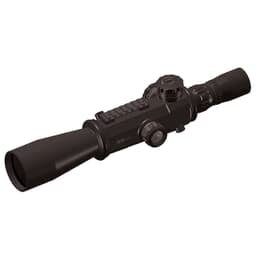

March Genesis Tactical 6-60x56G FML-MT Reticle 0.05MIL Illuminated FFP Riflescope offers a broad magnification range suited for extreme long-range shooting. Featuring a remarkable 400 MOA elevation adjustment, this scope allows for precise targeting adjustments, ensuring accuracy at various distances. The unique design incorporates an integral scope base/mount that enables significant elevation and windage travel, setting it apart from standard riflescopes.
Equipped with March’s HighMaster Lens System, this riflescope provides exceptional edge-to-edge clarity and true-to-life color reproduction. The Temperature Anti-Drift Lens System ensures consistent performance across varying environmental conditions, adapting to changes in temperature for reliable targeting. Ultimately, the combination of these advanced technologies enhances the overall shooting experience, making it an ideal choice for precision shooters.
Features:
- EXTENSIVE MAGNIFICATION RANGE for versatile shooting scenarios, from close targets to long distances.
- 400 MOA ELEVATION ADJUSTMENT allows for precise targeting, accommodating various shooting environments.
- HIGHMASTER LENS SYSTEM delivers superior image quality with minimal chromatic aberration for clarity.
- TEMPERATURE ANTI-DRIFT LENS SYSTEM adapts optics to environmental changes, maintaining focus accuracy.
- INTEGRAL MOUNTING SYSTEM enhances stability and simplifies setup, ensuring reliable performance.
- FIRST FOCAL PLANE RETICLE maintains accurate subtensions at all magnification levels for better holdover.
- ILLUMINATED RETICLE improves visibility in low-light conditions, enhancing shooting opportunities at dawn or dusk.
- DURABLE CONSTRUCTION ensures reliability in harsh environments, making it suitable for tactical use.
Technical Specifications
SKU
D60V56GFIML-FML-MT-March
UPC
4570058002135
Magnification
6x - 60x
Objective Diameter
56mm
Field of View
21.8 - 2.18ft at 100yds
Weight
52.2oz
Eye Relief
Low: 2.64-3.23in | High: 2.48-3.25in
Reticle Type
FML-MT Reticle
Reticle Illumination
Yes
What's in the Box?
- March Genesis Tactical 6-60x56G FML-MT Riflescope
- Lens covers
- Integrated mount
Customer Reviews
"The clarity and precision of this scope are unmatched. I can easily spot targets at long range." - Chris T.
"Perfect for competition shooting, the adjustments are precise and easy to use." - Jamie L.
FAQ
What is the effective range of the March Genesis 6-60x56G? The scope is designed for extreme long-range shooting, with capabilities extending well beyond 1000 yards. Users have effectively engaged targets at distances over 2000 yards with proper calibration.
How do I maintain the scope for optimal performance? Regularly clean the lenses with a soft cloth and lens cleaner. Ensure that the turrets and adjustments are free of dirt and debris. Store in a dry place to prevent moisture damage.
How does this scope compare to other high-end brands? This riflescope offers superior optical clarity and a higher elevation adjustment range compared to many competitors, making it a preferred choice for serious marksmen.
Similar Models
Explore our selection of March scopes, including the March 4-40x52 for versatile magnification and the March 8-80x56 for unparalleled precision. Each model offers unique features tailored to enhance your shooting experience.
You May Also Like
Here’s some of our most similar products people are buying. Click to discover trending style.







